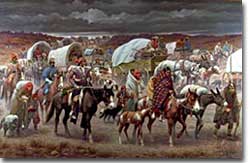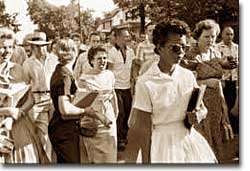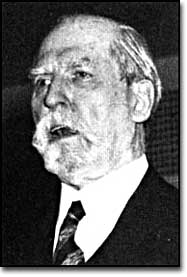9e. The Power of the Federal Courts
Not everyone agrees on how much power the judicial branch should have. After all, federal judges and justices are appointed, not elected. As most Americans believe in democracy, shouldn't elected officials run the country?
On the other hand, perhaps American government would be fairer if judges had even more power. Because they do not have to worry about reelection, they are relieved of the outside pressure of public opinion.
After all, the majority is not always right. It is no accident that the Founders provided for elected officials in the legislature and appointed officials in the judiciary. They believed that freedom, equality, and justice are best achieved by a balance between the two branches of government.
Checks on Judicial Power

Although the Supreme Court ruled in favor of the Cherokee, its decision was not enforced. Nearly 4,000 Cherokee died on the Trail of Tears as a result of the Indian removals.
The president and Congress have some control of the judiciary with their power to appoint and confirm appointments of judges and justices. Congress also may impeach judges (only seven have actually been removed from office), alter the organization of the federal court system, and amend the Constitution.
Congress can also get around a court ruling by passing a slightly different law than one previously declared unconstitutional.
Courts also have limited power to implement the decisions that they make. For example, if the president or another member of the executive branch chooses to ignore a ruling, there is very little that the federal courts can do about it.
For example, the Supreme Court ruled against the removal of the Cherokee from their native lands in 1831. President Andrew Jackson disagreed. He proceeded with the removal of the Cherokee, and the Supreme Court was powerless to enforce its decision.
The Power of the Courts

The federal courts' most important power is that of judicial review, the authority to interpret the Constitution. When federal judges rule that laws or government actions violate the spirit of the Constitution, they profoundly shape public policy. For example, federal judges have declared over 100 federal laws unconstitutional.
Another measure of the Supreme Court's power is its ability to overrule itself. In 1954, the Supreme Court ruled in Brown v. Board of Education of Topeka that schools segregated by race were unconstitutional. This reversed the 1896 Plessy v. Ferguson decision that upheld the doctrine of "separate but equal."
For the most part, though, federal courts do have a great deal of respect for previous decisions. A very strong precedent called stare decisis ("let the decision stand") directs judges to be cautious about overturning decisions made by past courts.
|
An act of the legislature repugnant to the Constitution is void.... It is emphatically the province of the judicial department to say what the law is. Words which, ordinarily and in many places, would be within the freedom of speech protected by the First Amendment, may become subject to prohibition when of such a nature and used in such circumstances as to create a clear and present danger that they will bring about the substantive evils which Congress has a right to prevent. The character of every act depends upon the circumstances in which it is done. The judgments below, except that, in the Delaware case, are accordingly reversed, and the cases are remanded to the District Courts to take such proceedings and enter such orders and decrees consistent with this opinion as are necessary and proper to admit to public schools on a racially nondiscriminatory basis with all deliberate speed the parties to these cases. I shall not today attempt further to define the kinds of material [pornography] ...[B]ut I know it when I see it.  Charles Evans Hughes was first appointed to the Supreme Court in 1910, but left the Court to run for president in 1916. He was reappointed to the Supreme Court as Chief Justice in 1930. | ||
Judicial Activism versus Judicial Restraint
The lack of agreement regarding the policy making power of courts is reflected in the debate over judicial activism versus judicial restraint. Judicial activists believe that the federal courts must correct injustices that are perpetuated or ignored by the other branches.
For example, minority rights have often been ignored partly because majorities impose their will on legislators. Prayers in public schools support the beliefs of the majority but ignore the rights of the minority. The Constitution is often loosely interpreted to meet the issues of the present. In the words of former Justice Charles Evans Hughes, "We are under a Constitution, but the Constitution is what the judges say it is."
Supporters of judicial restraint point out that appointed judges are immune to public opinion, and if they abandon their role as careful and cautious interpreters of the Constitution, they become unelected legislators. According to Justice Antonin Scalia, "The Constitution is not an empty bottle....It is like a statute, and the meaning doesn't change."
Despite the debate over what constitutes the appropriate amount of judicial power, the United States federal courts remain the most powerful judicial system in world history. Their power is enhanced by life terms for judges and justices, and they play a major role in promoting the core American values of freedom, equality, and justice.







